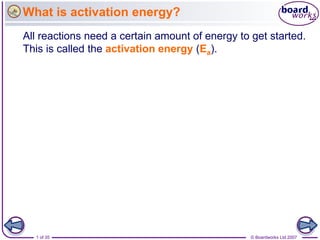IGCSE 11.1.13
- 1. What is activation energy?
All reactions need a certain amount of energy to get started.
This is called the activation energy (Ea).
1 of 35 © Boardworks Ltd 2007
- 2. What is activation energy?
All reactions need a certain amount of energy to get started.
This is called the activation energy (Ea).
Activation energy is needed to start breaking the bonds of
the reactants. In most chemical reactions, some existing
bonds need to be broken (an endothermic process) before
new bonds can be made (an exothermic process).
2 of 35 © Boardworks Ltd 2007
- 3. What is activation energy?
All reactions need a certain amount of energy to get started.
This is called the activation energy (Ea).
Activation energy is needed to start breaking the bonds of
the reactants. In most chemical reactions, some existing
bonds need to be broken (an endothermic process) before
new bonds can be made (an exothermic process).
3 of 35 © Boardworks Ltd 2007
- 4. What is activation energy?
All reactions need a certain amount of energy to get started.
This is called the activation energy (Ea).
Activation energy is needed to start breaking the bonds of
the reactants. In most chemical reactions, some existing
bonds need to be broken (an endothermic process) before
new bonds can be made (an exothermic process).
Ea
4 of 35 © Boardworks Ltd 2007
- 5. What is activation energy?
All reactions need a certain amount of energy to get started.
This is called the activation energy (Ea).
Activation energy is needed to start breaking the bonds of
the reactants. In most chemical reactions, some existing
bonds need to be broken (an endothermic process) before
new bonds can be made (an exothermic process).
Ea
5 of 35 © Boardworks Ltd 2007
- 6. Do different reactions need different Ea?
In some reactions, the bonds are easily broken and a low
activation energy is needed; for example, the reaction
between sodium hydroxide and water starts at room
temperature.
6 of 35 © Boardworks Ltd 2007
- 7. Do different reactions need different Ea?
In some reactions, the bonds are easily broken and a low
activation energy is needed; for example, the reaction
between sodium hydroxide and water starts at room
temperature.
In other reactions, the
bonds are strong and
not easily broken. The
reaction needs lots of
activation energy.
7 of 35 © Boardworks Ltd 2007
- 8. Do different reactions need different Ea?
In some reactions, the bonds are easily broken and a low
activation energy is needed; for example, the reaction
between sodium hydroxide and water starts at room
temperature.
In other reactions, the
bonds are strong and
not easily broken. The
reaction needs lots of
activation energy.
An example is the
combustion of charcoal
(carbon) – it needs lots
of heating before it will
start to burn.
8 of 35 © Boardworks Ltd 2007
- 9. Do different reactions need different Ea?
In some reactions, the bonds are easily broken and a low
activation energy is needed; for example, the reaction
between sodium hydroxide and water starts at room
temperature.
In other reactions, the
bonds are strong and
not easily broken. The
reaction needs lots of
activation energy.
An example is the
combustion of charcoal
(carbon) – it needs lots
of heating before it will
start to burn.
9 of 35 © Boardworks Ltd 2007
